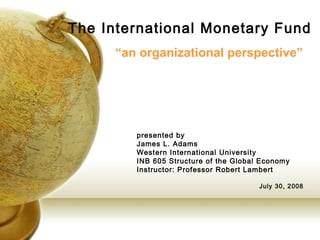
The IMF Structure
- 1. The International Monetary Fund “an organizational perspective” presented by James L. Adams Western International University INB 605 Structure of the Global Economy Instructor: Professor Robert Lambert July 30, 2008
- 2. The IMF Organizational Background History March 31, 2008 • IMF was founded by John Maynard • Headquartered: Washington, Keynes and 44 charter nations DC during the United Nations Monetary • Member nations: 185 and Financial Conference in July • Employees: 2600 1944 as the Bretton Woods Institution. • Funds Available: $209.5 billion • Headquartered: Bretton Woods, • Loans Outstanding: $16.1 billion New Hampshire • 64 Countries owe the IMF (total) • Recognized in December 27, 1947 • 56 Countries are low-income as the International Monetary Fund owed $6.5 billion with 29 of the 44 members • 8 Countries (are not low- remaining. income) owed $9.6 billion
- 3. Purpose of the IMF IMF Agenda 3 Primary Tasks of IMF • Facilitate global monetary • Surveillance exchange • Monitoring financial & economic • Promote exchange stability activities to develop policies, strategies & recommendations for • Organize exchange arrangements proactive crisis prevention. • Foster economic growth • Lending • Enhance higher employment • Funding for short-term, low-interest • Provide temporary financial loans for macroeconomic issues assistance related to political & economic stability. • Provide training & advice for • Technical Assistance balance of payment issues • Training & consultation for loan applications, policy reforms and the interpretation of data.
- 4. Surveillance Multi-lateral (Macro-economic) Bi-Lateral (Micro-economic) • Annual evaluation process for • Economist visit member states all member nations based on individually to gather their financial expert information from the nation’s assessments of economic and central bank and officials, and financial developments. conduct meetings pertaining to • Reason: To assess that nation’s economy. vulnerabilities, threats, trends • The Economist then submit and developments in the whole formal reports to the Executive international economy. Board of the IMF. • The Executive Board makes recommendations to the central bank officers and file a transparent Public Information Notice of the data. • Reason: To ensure compliance with the Articles of Agreement.
- 5. Lending The Lending Process 2. Any member of the IMF may request funding. 3. Agree to abide by the transparency standards, codes and policies of the facility. 4. Agree to a balance of payment resolution. 5. Bi-lateral Surveillance is conducted on current economic conditions. 6. Submit a repayment strategy including the policy change recommendations in a Letter of Intent to the Executive Board of the IMF for approval. Poverty Reduction & Growth Facilities and Exogenous Shock Facilities are loans programs for impoverished nations with concessional interest rates (about 0.5%) with special terms and grace periods for repayment.
- 6. Facilities Facilities are loan programs set-up by the IMF to address specific needs of member nations. It should also be noted that IMF funding is disbursed in phases so that adjustments may be made to mitigate risk. Facility Purpose Type Duration Repay Surcharge Stand By Arrangements BoP Short- 1 – 2 yrs 2 - 4 yrs Avg 4% (Most lucrative loan.) term Extended Fund Facility BoP Long- 3 yrs 5 – 7 yrs (Recommended Reforms) Term Supplemental Reserve Economic Short- 1 yr 1 – 1.5 Avg 4% Facility Recovery term yrs (Developing Nations) Large- scale Compensatory Financing Drop in Short- 1 – 2 yrs 2 - 4 yrs financing Facility Export term (Global Commodity Price Earnings Issues) Emergency Assistance Disaster Long-term 3 - 5 yrs Loans Recovery (Base (Disasters & Post-War) Rate) (Subsidies may be available)
- 7. Technical Assistance • 1/5 th of IMF Budget goes to Technical Assistance • Missions can be dispatched from Headquarters to train central bank executives and officials. • Online courses are provided for members to train. • Seminars & Workshops • Seven Regional Training Institutes located worldwide. • Asian Development Bank, African Regional Bank and others provide multi-lateral funding. • The goal is to educate to empower financial leaders in an effort to sustain and grow a strong international economy.
- 8. Funding Process Overview 1. Member nation identifies a need from surveillance & evaluation data. 2. Implementation of policy changes and recommendations for compliance. 3. File Letter of Intent. 4. Monitor the use of phased funding and economic conditions, watching expenditures, growth and lowering of BoP. 5. Evaluation of previous disbursements, economic trends, growth and impact to correct problem. 6. Reassess and resolve unforeseen results due to policy changes, economic conditions and external factors.
- 9. Distinctions – IMF & World Bank • Both were created due to a difference in financial labor and responsibility. • World Bank • Funds individual projects to serve the public good such as dam construction, roads and other infrastructure related projects. • Makes longer-term loans. • Requires IMF Membership. • International Monetary Fund • Does not issue funds for individual projects. • Focuses on BoP issues. • Provides facts, statistics and information.
- 10. The Future of the IMF • Surveillance has been broadened to include capital markets and investments. • Transparency Standards & Codes have been enhanced in banking supervision, accounting and many aspects of the global financial infrastructure to thwart terrorist activities through money laundering and illicit use of the international financial system. • Member nations will face challenges in trying to adhere to policies and apply and ratify them in their own countries. • Membership will expand with nations rising in status and assuming more financial responsibility.
